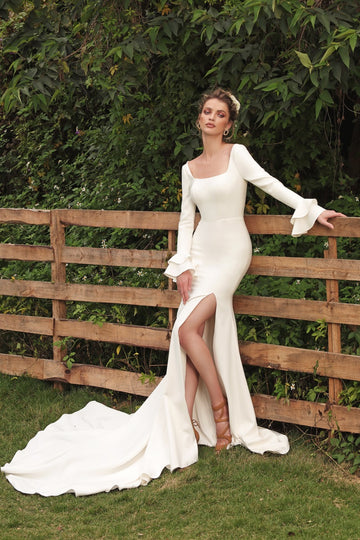Ultimate Guide to Selecting the Ideal Fabric for Your Wedding Dress
Ultimate Guide to Selecting the Ideal Fabric for Your Wedding Dress
Your wedding day is one of the most memorable occasions of your life, and your wedding dress plays a pivotal role in making it magical. Choosing the right fabric can significantly influence the comfort, style, and overall look of your gown. In this comprehensive guide, we will explore various fabrics, their characteristics, and how to select the ideal fabric for your wedding dress.
Understanding Wedding Dress Fabrics
When selecting a wedding dress, it is essential to become acquainted with different fabrics available in the market. Each material offers unique qualities, and understanding them will assist in making an informed choice. Here are some popular fabrics used in wedding dresses:
| Fabric Type | Characteristics | Best For |
| Satin | Soft, luxurious, and has a slight sheen. | Elegant ball gowns and structured silhouettes. |
| Tulle | Lightweight and sheer, often used for overlays. | Romantic gowns with a fairy-tale vibe. |
| Lace | Delicate, textured, and often features intricate designs. | Vintage or classic-style dresses. |
| Chiffon | Soft and flowing, perfect for lightweight gowns. | Beach or outdoor weddings. |
| Organza | Stiff and crinkly, adds volume to any dress. | Structured gowns and layered skirts. |
Factors to Consider When Choosing Fabric
1. Seasonality
The season in which you plan to have your wedding can significantly influence your fabric choice. For example, if you're planning a summer wedding, lightweight fabrics like chiffon or tulle are ideal for staying cool. Conversely, if your wedding is in winter, heavier fabrics like satin or velvet will offer warmth and elegance.
2. Venue
The location of your wedding should also dictate your fabric choice. A beach wedding may call for breezy chiffon or flowy tulle that moves effortlessly in the wind, while a formal church ceremony may be best complemented by heavier fabrics like brocade or satin.
3. Body Type
Your body shape and size should guide your fabric selection as well. For instance, structured fabrics can provide support and shape for curvier figures, while lighter, flowing fabrics often flatter a more petite frame. Understanding your body type will help you choose the best look for your wedding day.
4. Comfort
Don’t compromise on comfort for style. You’ll be wearing your wedding dress for several hours, so selecting a fabric that feels good against your skin is crucial. Consider breathable fabrics that allow movement and don’t constrict your body, helping you enjoy the day fully.
5. Budget
Fabric types can vary in price dramatically. While silk and satin may provide a luxurious appearance, they also come with higher price tags. It’s vital to establish your budget beforehand and research which fabrics fit within your financial range without sacrificing style.
Popular Wedding Dress Fabrics Explained
Satin
Satin is a favored choice for many brides due to its luxurious appearance and smooth texture. This fabric drapes beautifully and is ideal for structured-style gowns. Satin is versatile enough to be used in both simple and elaborate designs. However, it can be heavier, which is why it may be best suited for fall or winter weddings.

Tulle
Tulle is a lightweight mesh fabric that works wonderfully for romantic or whimsical bridal gowns. It's often used in layers or as overlays, creating soft silhouettes reminiscent of fairy-tale princesses. Tulle is perfect for summer and spring weddings due to its airy nature.
Lace
Lace is timeless and adds a vintage flair to wedding gowns. Whether used as an overlay or in intricate designs, lace can bring an element of romance and sophistication to your dress. It's incredibly versatile, fitting into various styles from classic to bohemian. However, keep in mind that lace may require a bit more care in terms of cleaning and maintenance.
Chiffon
Chiffon is another lightweight fabric that drapes beautifully and offers a sense of airiness. It's often used in flowing gowns and can create stunning layers and movement. Chiffon is ideal for outdoor weddings or beach ceremonies, allowing for comfort during warm weather.
Organza
Organza is a crisper fabric that adds structure and volume, making it perfect for ball gowns. Its sheer qualities also allow for layering, providing depth and dimension to your dress. Organza can be a fantastic choice for formal settings, especially when paired with luxurious satin or lace underlayers.
Additional Tips for Selecting the Perfect Fabric
1. Sample Swatches
Always request fabric swatches before making your final decision. This will give you a tangible sense of the texture and weight, and help visualize how it will look in a complete gown.
2. Consider Future Use
Some brides may consider the potential for future wear of their wedding dress. If you’re interested in reusing elements of your gown, think about how certain fabrics may hold up over time.
3. Work With A Designer
If you're unsure about what fabric will work best, consult with a designer. They can provide insights tailored to your body type, style preference, and wedding theme.
4. Don't Rush the Decision
Choosing the right fabric takes time. Don't rush this decision; take the time to explore your options completely and choose a fabric that feels perfect to you.
Conclusion
Selecting the ideal fabric for your wedding dress is one of the essential steps in ensuring you feel beautiful and comfortable on your special day. From understanding fabric types to considering factors like seasonality and comfort, this guide provides valuable insights to make the process smoother. Don’t forget to trust your instincts and keep the focus on what makes you feel the best. Remember, your wedding dress should be a reflection of your personal style and love story. Happy planning!
